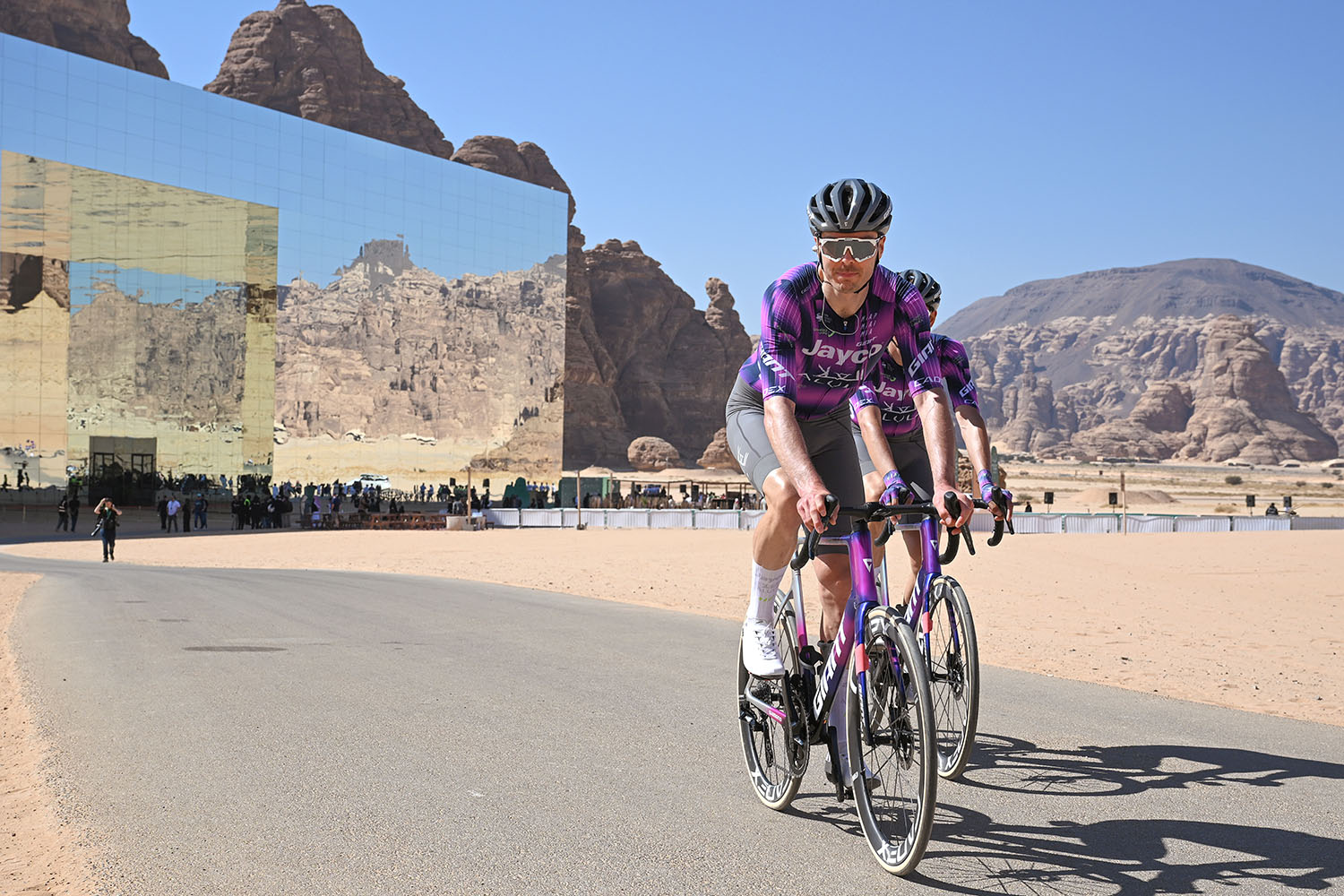Talking tech with the Paris-Roubaix mechanics: Clever hacks, pre-race stress and V6 Audis
Nine team mechanics share their Paris-Roubaix setup, with a few neat tricks unearthed
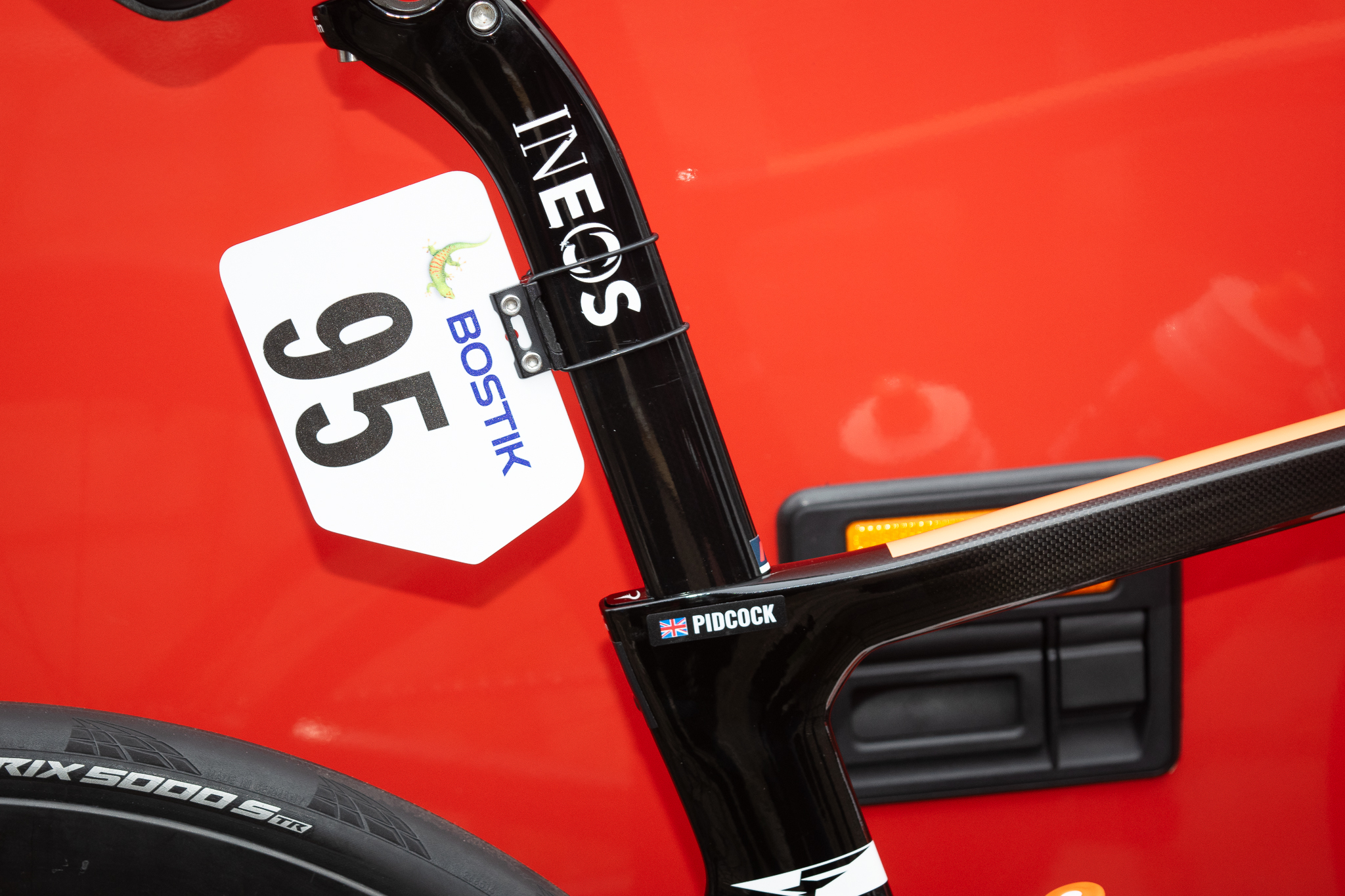
Paris-Roubaix is surely one of the biggest tests of the year for bike mechanics. The challenging pavé of the Hell of the North means many mechanics consider it one of the biggest days of their year.
For pro team mechanics, bikes need to be perfect for every race at the top level. However, due to the added demands created by the terrain, Paris-Roubaix requires an extra level of preparation and planning to ensure everything goes to plan. Whether it's race logistics, spares or the bikes themselves, Roubaix steps things up a notch. Mechanicals are more frequent, whether it's a flat tyre or mechanical equipment issue from the bone-jarring cobbles, so all team mechanics on the race have an important job to do.
I spoke to as many team mechanics as I could at the start of the men's race in Compiègne to get their take on bike prep and how to deal with the demands of the race. There was a common theme from those I spoke with, which is that these days at Roubaix, everyone wants the fastest setup possible, something wider rims and larger volume tyres has made possible.
By the morning of the race, nearly all of the bike prep is done. The mechanics unload bikes from team cars in the crisp morning air, rack the bikes and check tyre pressures. All of the other work is done at this stage, and within a few short hours, their hard work is being subjected to road cycling's ultimate test.
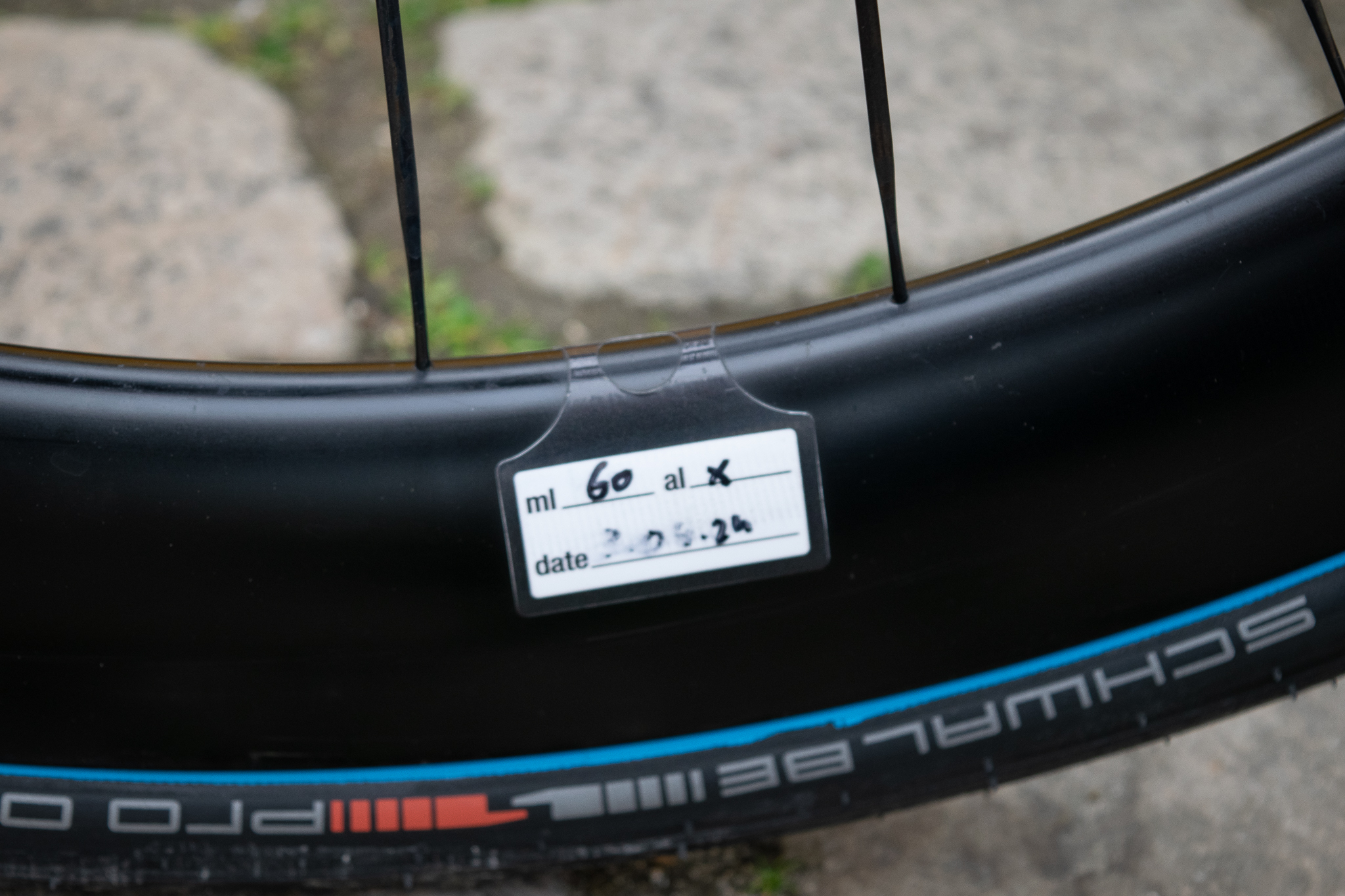
Uno-X Pro Cycling Team
The first stop was Uno-X and a chat with Frederik Svendsen, a team mechanic who was happy to talk to me about the team bike setup and seemed calm and collected before the race. We also spotted a brand new Dare bike being ridden by Alexander Kristoff parked up outside their team bus.
He also agreed on bike choices for the men's race focusing on speed, saying "Everyone wants the fastest option". He didn't admit to feeling the pressure, especially at Roubaix, but said it was top of the list of one-day races for him. "It's Paris-Roubaix, for me it's the biggest race of the year, it's a bit more work, but I really like to get the small details right."
This extended to bike checks, Svendsen said the work was done, and the day of the race was only for tyre pressure setup and checks. The team used 70ml of tubeless sealant (despite the 60ml sticker in the above pic) in its Schwalbe tyres, as well as a tyre liner.
The latest race content, interviews, features, reviews and expert buying guides, direct to your inbox!
"Today we are not checking anything, only the tyre pressure, this morning and again in a bit." I got the impression that constantly faffing and checking bikes on the morning of the race was to be avoided and would only add extra stress. Confidence in the prep work being done right seemed key.
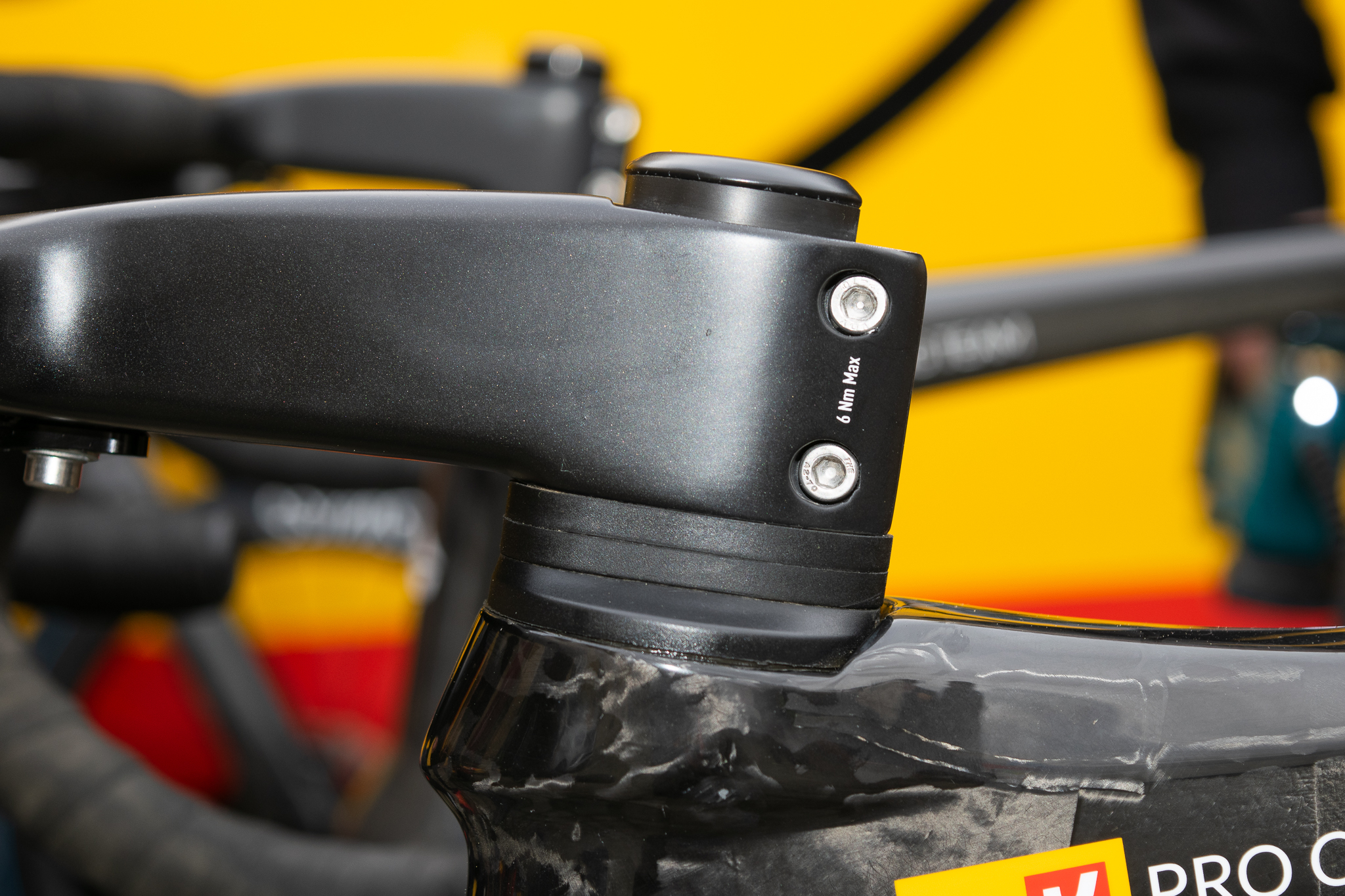
He also explained an interesting subtlety and extra insurance relating to the team's Dare bike fork steerer tubes. Explaining that the team leaves a 5mm spacer above the handlebar stem, as some other teams do, to allow the top stem bolt to spread its load more evenly across the steerer tube material. Minimising the chance of a failure here. "We install longer forks on the bikes, to make sure the bolts on the stem have more material to hold, with a 5/10mm spacer on top. We use the same expander in the fork." This means new forks for all team Roubaix bikes, and the associated recabling and re-brake bleeding.
I was also interested in getting a feel for what chain preparation teams were doing at Roubaix, and Svendsen explained that Uno-X uses a drip wax.
My final question in the time we had was on tools. Svendsen told me he also always uses a torque wrench on team bikes, not his own feel, and finished up by saying his tools are all his own and that he favours tools from Swiss brand PB Swiss.
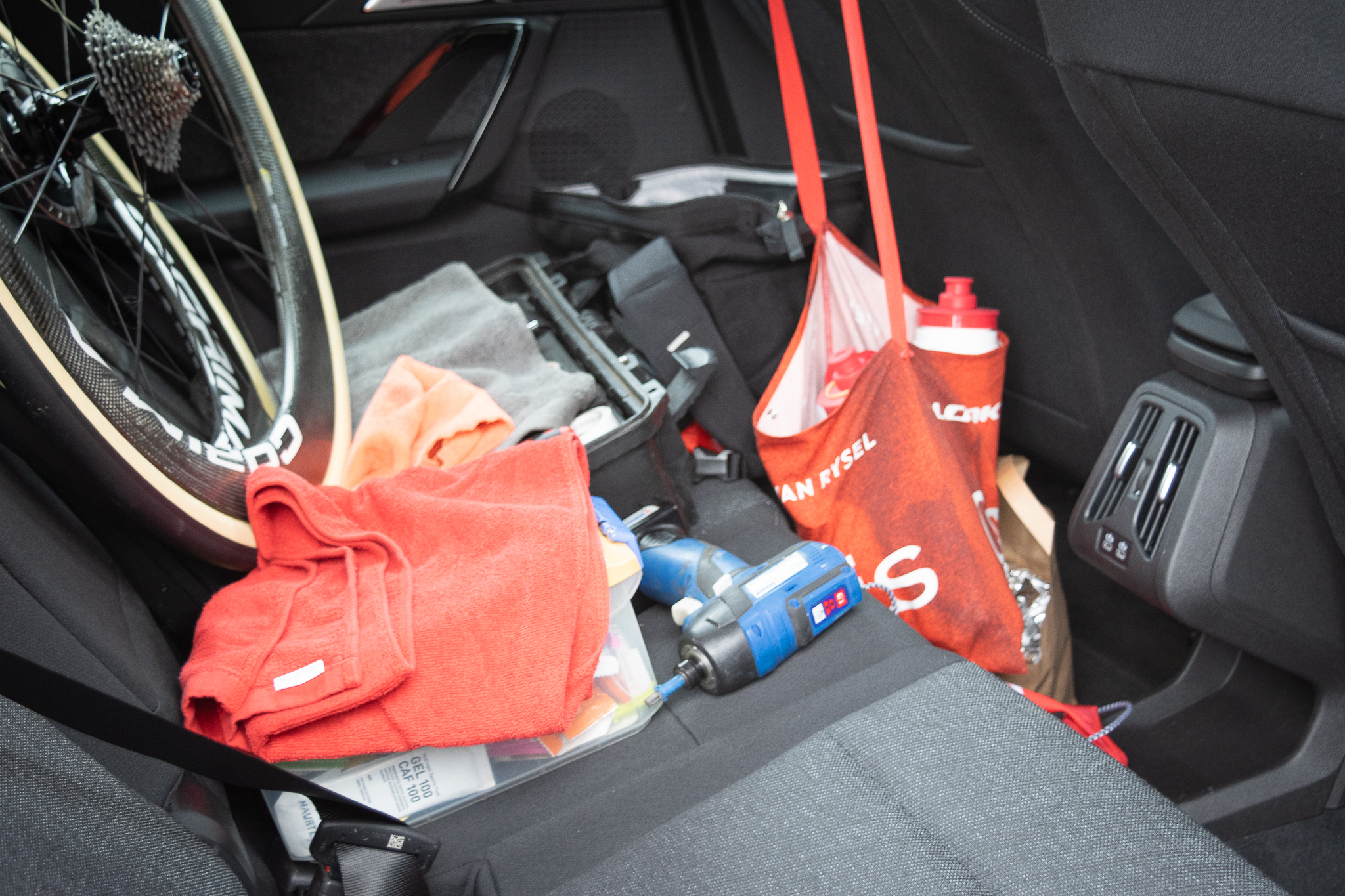
Cofidis
Next was a visit to Cofidis, I managed to speak to Benjamin Giraud, the team's Sports Director whilst the mechanics were all busy. On the team's setup, he told me "We use a normal bike from Look, we use this one all season," agreeing with my suggestion that most teams were just using normal race bikes now, with only minor concessions for the cobbles.
Cofidis notably are a team still using tubular tyres - probably no bad thing for Roubaix - which are glued onto Corima carbon wheels, another French brand. "We use a Michelin tubular in a 30mm, we put sealant inside the tubular tube". Tubulars use a sewn-in inner tube and the removable valve stem core means the team can add sealant to them for a sort of best-of-both-worlds combo.
In terms of special Roubaix tricks, there wasn't anything earth-shattering but Giraud told me "we use Heli tape for the computer mount, some riders also like to add double handlebar tape or bar on the flat part of the bar". The flat tops of some aero bars are harder to hold on the cobblestones without bar tape.
Elsewhere, it's common for teams also use different team cars for Roubaix with higher ground clearances, and Cofidis also does the same. "We use two types of team car, and we use the SUV for Roubaix, it's higher and we add underbody protection."
Ineos Grenadiers

From a Roubaix tech perspective, the Ineos setup - or at least what the team would tell me - is pretty standard. They continue to use their stock Pinarello Dogma F frames and components, just going up in tyre size and running a couple of 1X drivetrains including a huge chainring on Josh Tarling's bike which you can see in our Roubaix men's tech gallery.
I asked one of the mechanics about setup whilst he finalised tyre pressure checks, and if there were any special changes. "Just the wider tyres," he told me. "32mm size, otherwise a pretty similar setup with a tyre insert". Ineos-Grenadiers bikes were fitted with Continental GP5000 S TR tyres, however, the amount of sealant used in the tyres, which other mechanics shared freely, was closely guarded.
He also explained Ineos have their own protocol in place for torquing all of the bolts on the bikes. He didn't expand but we assume this is a systematic check to ensure nothing is missed. He also added they usually don't use Loctite.
On dealing with the pressure, he gave an insight into the Ineos mentality. "Every race is the same, you have to be focused, no small-race mentality." At the top level, this shows Ineos mechanics are expected to turn up and perform, no matter the race.
Intermarché-Wanty

Next, I headed to Intermarché-Wanty and spoke with team mechanic Aloïs Gevaert.
As with other teams, it sounded as though things were fairly standard at Intermarché, with the team riding their stock race bikes, the Cube Litening being the model of choice. The handlebars were also fitted with special grippy new handlebar tape from Prologo which my colleague Will first spotted at Opening Weekend.
Gevaert said their setup was "pretty standard, only the tyres and pressure are different, tyres are 32mm Continental GP5000 All Season TR." Notably, not all teams used the Continental GP5000 AS TR option, with some like Ineos Grenadiers going for the S TR model.
He also explained something the Intermarché mechanics do that I didn't hear from any other team. "For the cobbles, we also remove an extra link for the chain so it doesn't jump off," he said. The theory is that this will aid chain retention and possibly prevent unwanted chain drops on the cobbles. A too-short chain in certain ratios probably isn't an issue for the gear range needed for the largely flat Paris Roubaix.
Gevaert also told me he would rather have as many tools as possible with him in the team car. "Full toolkit, always, just to be sure, I take everything". Surely It's better to have something and not need it than get caught short at Roubaix.
Bingoal Pauwels Sauces WB

Bingoal Pauwels Sauces WB is a UCI WorldTeam, a rung down from the WorldTour, and counts Classics legend and 2003 Paris-Roubaix champion Peter van Petegam as a member of team management.
They were riding De Rosa Merak bikes for Roubaix, an all-around race bike. The team were also using the new Hutchinson Blackbird tyres in a 30mm size and with 35ml of sealant, around half what some other teams were using. They were also using Dura-Ace groupsets and Ursus 47mm wheels.
I caught mechanic Stephen Dent before the race to ask a few questions on team setup and how he likes to work. He also told me that extra comfy bikes weren't required for Roubaix, saying "the bikes are at such a top level, we don't need to switch to special ones for Roubaix."
On torque and trying to ensure nothing came loose on the Roubaix cobbles, Dent said "I run my own feel, it's each to their own, the other guys run a torque spec, it varies between mechanics."
On feeling the pressure, Dent said "there's a little bit more pressure, more stuff can go wrong, you never know."
EF Education-EasyPost
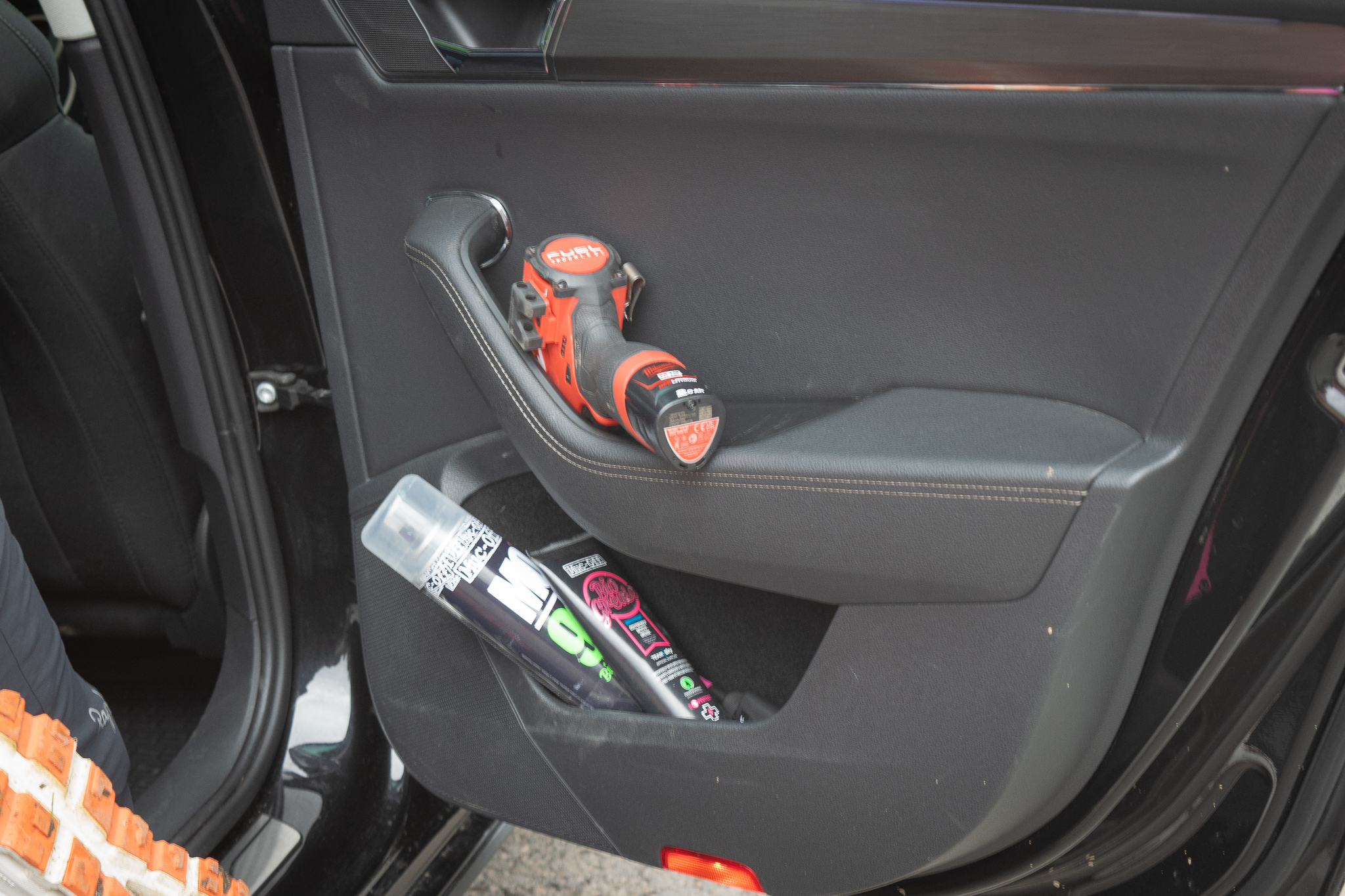
Next up was the bright pink bus and team cars of EF Education-EasyPost, and team mechanic Jac-Johann Steyn who was busy loading wheels into one of the team cars but happily gave me a few minutes of his time as the race helicopters hovered noisily overhead.
On the Cannondale bikes, Steyn said "bigger tyres, same bike for all season, nothing special from us."
Again, another team that seemed to just be riding a regular team race bike with larger volume tyres. They also just use regular chain oil on their chains, which is a loss of a few watts, in my opinion having researched and written our guide to the best bike chain lubes last year, but it doesn't seem to be doing them any harm.
A lot of the EF (and probably lots of other teams) main body of Roubaix pre-race work is done before the Classics, so it sounded like it was just a case of checking and maintaining things after that.
"It's just another race. It's three or four checks over the week. Our main work is done in-house at the service course before we depart for the Classics," he said. Steyn is an experienced race mechanic, and the most experienced mechanics seemed the calmest to me. He also described his matter-of-fact work style when it came to the bikes: "There's no special way of working or order, it's just getting the job done."
On his toolkit and setup, Steyn was another mechanic to carry the kitchen sink with him, saying "full toolkit in the car, but everything is normal, standard, no Loctite on the bolts."
EF mechanics don't have a tool sponsor and Steyn buys his own tools, but he said he didn't have favourites. "What works for you as a mechanic, that's the most important thing."
Bahrain-Victorious
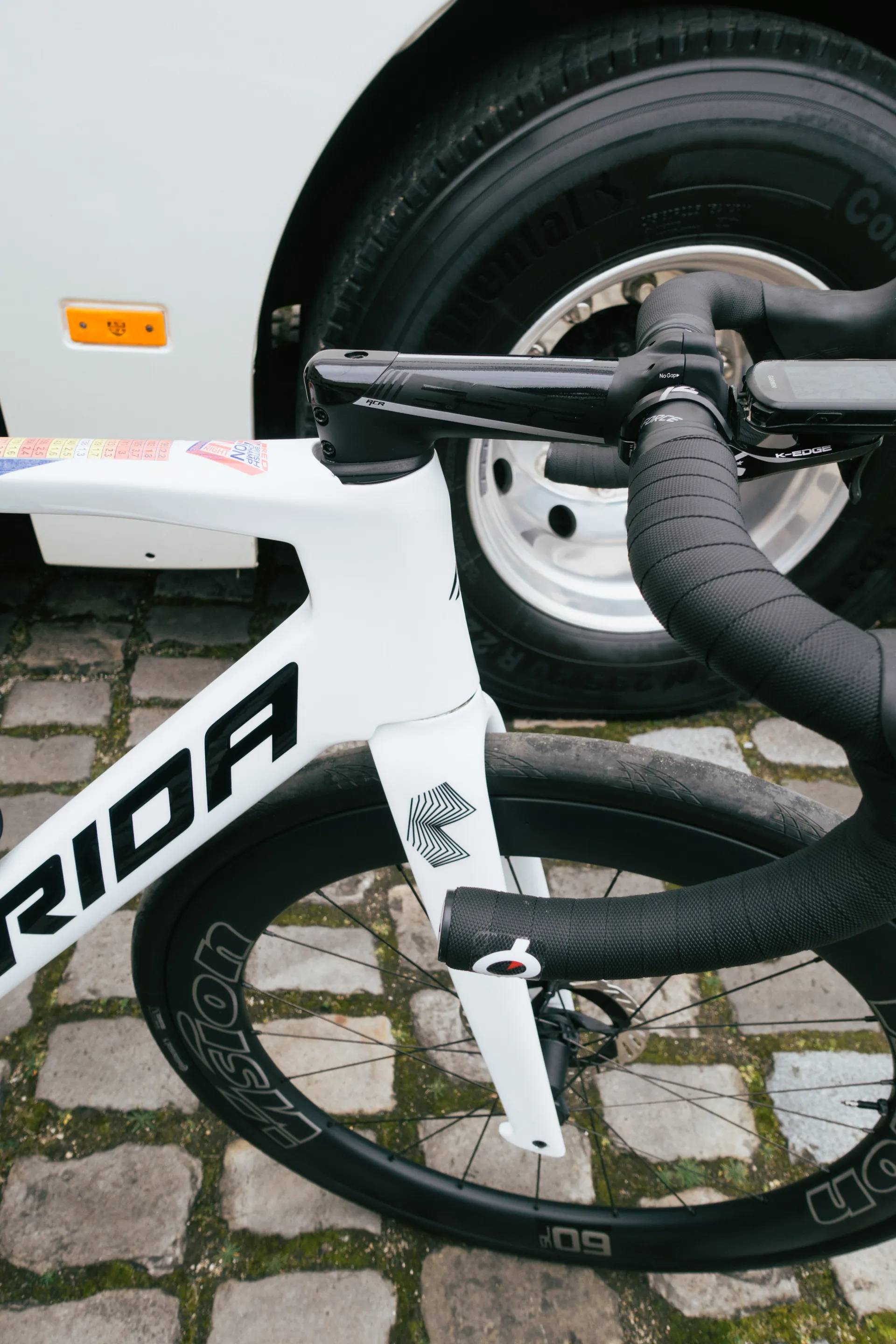
I spoke with race mechanic. Žarko Poštić at Bahrain-Victorious, who told me about Snap-on tools, V6-powered team cars and bike prep.
He explained the reasons why teams generally want the fastest setup possible for Roubaix to me: "You have to remember, the cobblestone parts of Roubaix make up part of the last 100km, the 160km to get there is road, so you need to strike a balance between the two."
160 kilometres in a rampaging WorldTour peloton on fairly smooth roads with a tailwind in places is going to be fast, as proven by the new record speed set by men's winner Mathieu van der Poel. A soft, comfy, slower road bike is just not something WorldTour racers are willing to choose for Roubaix anymore.
I saw some of the team bikes with deep 60mm Vision Metron wheels which would have been fast on the flat, though Poštić did tell me the team uses larger volume Continental tyres and tyre liners for protection.
On tools, Poštić also carried the works with him. "A full tool kit in the car, but you don't need it, if a guy needs your attention, it's finished." The narrow cobbled sectors of Roubaix means if a rider needs to wait for assistance, the front of the race will be gone.
Like EF mechanic Steyn, Poštić seemed cool, calm and ready. He told me about the Bahrain V6 Audi Classics car he was standing alongside. "We have Audi Allroads for this specific purpose, the cars have different differentials, and the normal two-litre Audi uses a transversely mounted engine but these cars have a longitudinally mounted V6, as well as Audi Allroad suspension. It's basically almost a truck. We have these in the team specifically for these types of races and this race."
After the V6 Audi, Poštić also dropped two tool sponsor names for the team that would make most tool nerds grin. "Snap-on and Bahco sponsor the team's tools, everything we use is by them except for a few extremely-specific tools which they don't make. Toys for the boys."
Most mechanics will agree a Snap-On tool sponsorship is a bit of a flex.
Visma-Lease a bike
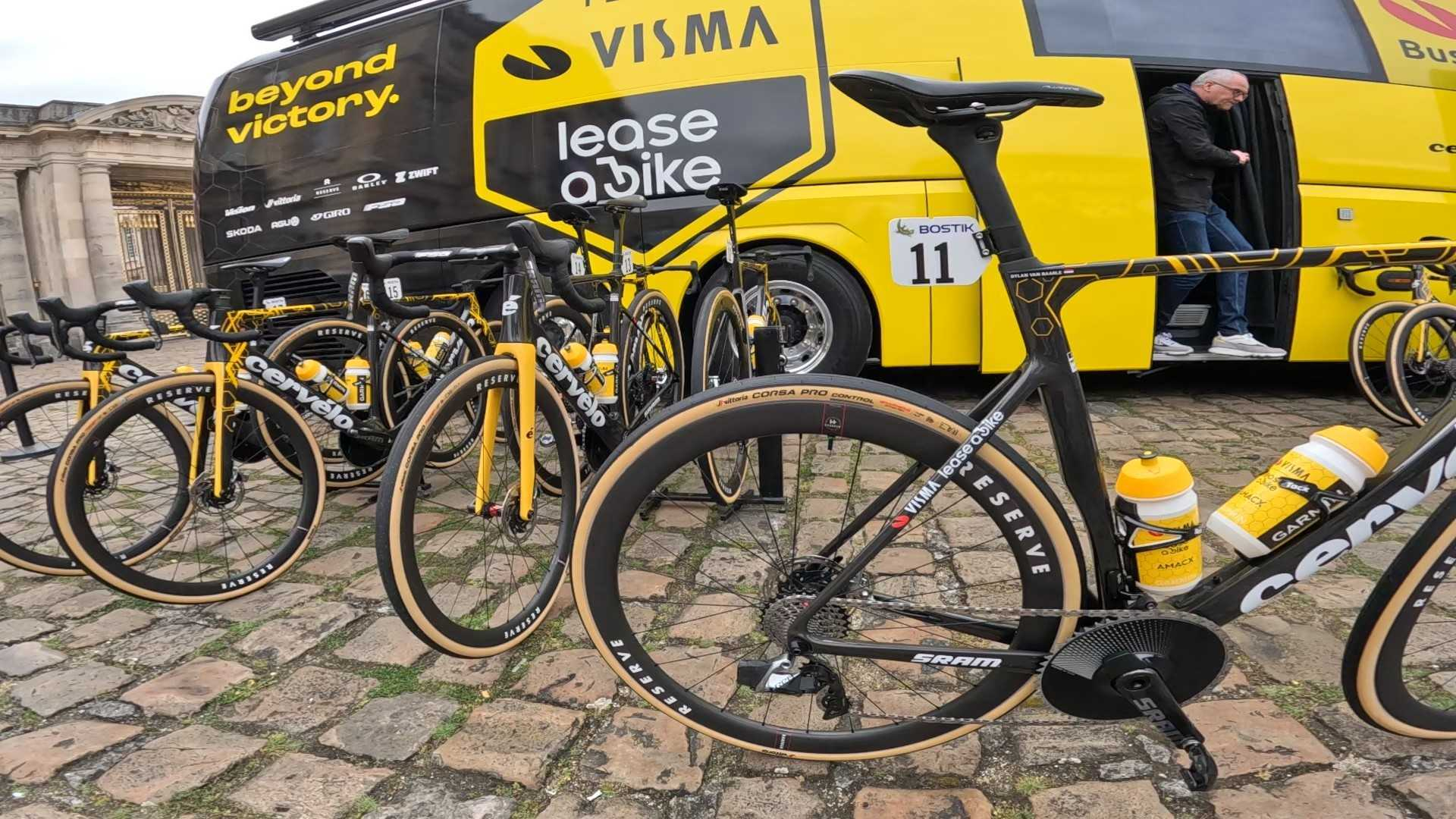
The yellow and black team bus of Visma-Lease A Bike is easy to spot and I caught Jenco Drost, Head of Performance Equipment, at the team for a few minutes.
Interestingly he told me the team were using the Cervelo Soloist, a more all-round bike and "a combination of stiffness, aero and comfort."
I would have expected them to use the aerodynamic S5 in the pursuit of all-out speed, but the Soloist is the teams preference for the Hell of the North.
He told me the team were using 32mm Vittoria Corsa tyres with around 60ml of tubeless sealant, and that the team use some Loctite thread lock compound on regular round handlebar stem bolts. This isn't needed on the integrated one-piece handlebar.
"My own feeling is almost a torque wrench, but we check with a torque wrench for sure," was Drost's answer when I asked about their use of the tool, highlighting his confidence in his own wrenching feel.
I have wanted to know for a while why the team seem to use DT Swiss 240 and not the lighter 180 hubs on its Reserve carbon wheels, and it seems the 240 is just a more workmanlike, durable option. Drost said "We normally use 240 hubs, they are more durable all around. For this type of work, we go for the 240, weight isn't an issue, especially at Roubaix."
He also seemed to echo the Ineos opinion on having no 'small race mentality'. "Work has to be perfect all the time, every race is a big race," again showing there is no room for error in the WorldTour when a mechanical could cost a team a race win.
Jayco AlUla

I spoke to mechanic Craig Geaton at the Jayco AlUla team truck just before the riders rolled out. This was Geaton's 23rd Paris-Roubaix as a mechanic and he's surely one of the most experienced mechanics in the WorldTour, with Team CSC being the first team he worked for.
Craig seemed cool, calm and pretty unphased by the Roubaix chaos going on around us. Like some of the other mechanics, he also confirmed that the team are using their regular race bikes except for one key change.
"We use exactly the same setup as we normally race on, apart from the tyres," he said. "The only thing we add is an airliner for the flemish classics, it protects our rims and riders can ride further" An airliner inside a tubeless tyre will give support and help keep it on the rim in the event of a flat.
Everything else at the Jayco AlUla truck really did seem stock with not much in the way of special touches. "No Loctite on bolts, just grease," Geaton said when I asked about it but said the team do use a quick-release lever for the wheels so riders can remove a wheel quickly.
In the team car following the race Craig packed the essentials. "My small tool bag, with basically everything I normally use." After 21 years, that's probably one well-organised tool setup.

Tom joined the Cyclingnews team in late 2022 as a tech writer. Despite having a degree in English Literature he has spent his entire working life in the cycling industry in one form or another. He has over 10 years of experience as a qualified mechanic, with the last five years before joining Cyclingnews being spent running an independent workshop. This means he is just as happy tinkering away in the garage as he is out on the road bike, and he isn’t afraid to pull a bike apart or get hands-on with it when testing to really see what it’s made of.
He has ridden and raced bikes from an early age up to a national level on the road and track, and has ridden and competed in most disciplines. He has a keen eye for pro-team tech and enjoys spotting new or interesting components in the wild. During his time at Cyclingnews, Tom has already interviewed some of the sport's biggest names including Mathieu van der Poel, Tadej Pogačar and Alberto Contador. He's also covered various launches from brands such as Pinarello, Ridley, Specialized and more, tackled the Roubaix Challenge sportive aboard his own rim-brake Cannondale SuperSix Evo, tested over 20 aero helmets in the wind tunnel, and has created helpful in-depth buying advice relating to countless categories from torque wrenches to winter clothing.
